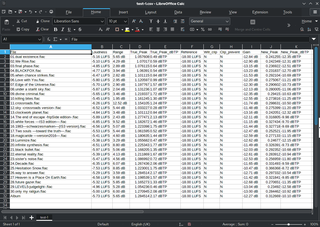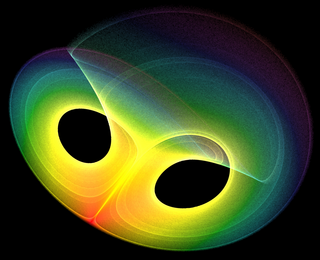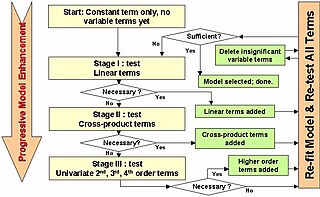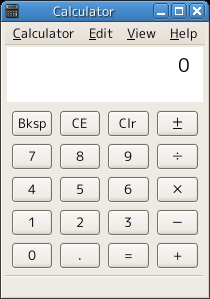Related Research Articles
Digital signal processing (DSP) is the use of digital processing, such as by computers or more specialized digital signal processors, to perform a wide variety of signal processing operations. The digital signals processed in this manner are a sequence of numbers that represent samples of a continuous variable in a domain such as time, space, or frequency. In digital electronics, a digital signal is represented as a pulse train, which is typically generated by the switching of a transistor.

A spreadsheet is a computer application for computation, organization, analysis and storage of data in tabular form. Spreadsheets were developed as computerized analogs of paper accounting worksheets. The program operates on data entered in cells of a table. Each cell may contain either numeric or text data, or the results of formulas that automatically calculate and display a value based on the contents of other cells. The term spreadsheet may also refer to one such electronic document.

Signal processing is an electrical engineering subfield that focuses on analyzing, modifying and synthesizing signals, such as sound, images, potential fields, seismic signals, altimetry processing, and scientific measurements. Signal processing techniques are used to optimize transmissions, digital storage efficiency, correcting distorted signals, improve subjective video quality, and to detect or pinpoint components of interest in a measured signal.

Analysis is the branch of mathematics dealing with continuous functions, limits, and related theories, such as differentiation, integration, measure, infinite sequences, series, and analytic functions.

Principal component analysis (PCA) is a linear dimensionality reduction technique with applications in exploratory data analysis, visualization and data preprocessing.
Pattern recognition is the task of assigning a class to an observation based on patterns extracted from data. While similar, pattern recognition (PR) is not to be confused with pattern machines (PM) which may possess (PR) capabilities but their primary function is to distinguish and create emergent patterns. PR has applications in statistical data analysis, signal processing, image analysis, information retrieval, bioinformatics, data compression, computer graphics and machine learning. Pattern recognition has its origins in statistics and engineering; some modern approaches to pattern recognition include the use of machine learning, due to the increased availability of big data and a new abundance of processing power.

A control system manages, commands, directs, or regulates the behavior of other devices or systems using control loops. It can range from a single home heating controller using a thermostat controlling a domestic boiler to large industrial control systems which are used for controlling processes or machines. The control systems are designed via control engineering process.

In mathematics, a time series is a series of data points indexed in time order. Most commonly, a time series is a sequence taken at successive equally spaced points in time. Thus it is a sequence of discrete-time data. Examples of time series are heights of ocean tides, counts of sunspots, and the daily closing value of the Dow Jones Industrial Average.
In mathematics and computer algebra, automatic differentiation, also called algorithmic differentiation, computational differentiation, and differentiation arithmetic is a set of techniques to evaluate the partial derivative of a function specified by a computer program. Automatic differentiation is a subtle and central tool to automatize the simultaneous computation of the numerical values of arbitrarily complex functions and their derivatives with no need for the symbolic representation of the derivative, only the function rule or an algorithm thereof is required. Auto-differentiation is thus neither numeric nor symbolic, nor is it a combination of both. It is also preferable to ordinary numerical methods: In contrast to the more traditional numerical methods based on finite differences, auto-differentiation is 'in theory' exact, and in comparison to symbolic algorithms, it is computationally inexpensive.
TK Solver is a mathematical modeling and problem solving software system based on a declarative, rule-based language, commercialized by Universal Technical Systems, Inc.
When classification is performed by a computer, statistical methods are normally used to develop the algorithm.

Stata is a general-purpose statistical software package developed by StataCorp for data manipulation, visualization, statistics, and automated reporting. It is used by researchers in many fields, including biomedicine, economics, epidemiology, and sociology.
The Goertzel algorithm is a technique in digital signal processing (DSP) for efficient evaluation of the individual terms of the discrete Fourier transform (DFT). It is useful in certain practical applications, such as recognition of dual-tone multi-frequency signaling (DTMF) tones produced by the push buttons of the keypad of a traditional analog telephone. The algorithm was first described by Gerald Goertzel in 1958.
Automatic parallelization, also auto parallelization, or autoparallelization refers to converting sequential code into multi-threaded and/or vectorized code in order to use multiple processors simultaneously in a shared-memory multiprocessor (SMP) machine. Fully automatic parallelization of sequential programs is a challenge because it requires complex program analysis and the best approach may depend upon parameter values that are not known at compilation time.
The behavioral approach to systems theory and control theory was initiated in the late-1970s by J. C. Willems as a result of resolving inconsistencies present in classical approaches based on state-space, transfer function, and convolution representations. This approach is also motivated by the aim of obtaining a general framework for system analysis and control that respects the underlying physics.

In statistics, stepwise regression is a method of fitting regression models in which the choice of predictive variables is carried out by an automatic procedure. In each step, a variable is considered for addition to or subtraction from the set of explanatory variables based on some prespecified criterion. Usually, this takes the form of a forward, backward, or combined sequence of F-tests or t-tests.

A software calculator is a calculator that has been implemented as a computer program, rather than as a physical hardware device.
PSI-Plot is a scientific and engineering data analysis and technical plotting software developed by Poly Software International, Inc. The software can read multiple formats and perform mathematical transforms and statistical analyses. PSI-Plot is maintained on Microsoft Windows operating systems, and the current version is 9.5 for Windows 98 to Windows 7.
PROSE was the mathematical 4GL virtual machine that established the holistic modeling paradigm known as Synthetic Calculus. A successor to the SLANG/CUE simulation and optimization language developed at TRW Systems, it was introduced in 1974 on Control Data supercomputers. It was the first commercial language to employ automatic differentiation (AD), which was optimized to loop in the instruction-stack of the CDC 6600 CPU.
References
- ↑ Mahmood Nahvi. "Real-Time Digital Signal Processing Design Projects in an Undergraduate DSP Course and Laboratory" (PDF). Texas Instruments DSPS Fest, 1999.
- ↑ "User Interactive Software for Analysis of Human Physiological Data". Nasa Tech Briefs, December 2006. December 2006.
- ↑ "DADiSP Makes Complex Data Analysis Faster and Easier". DSP Development Corp. Retrieved March 3, 2014.
- 1 2 "DADiSP 2002 Escape from the cell block". Scientific Computing World. Retrieved March 3, 2014.
- ↑ "DADiSP SPL vs. MATLAB". DSP Development Corp. Retrieved March 3, 2014.
- ↑ "DADiSP 6.7 B02 Release Notes". DSP Development Corp. Retrieved January 18, 2017.
- ↑ "DADiSP 6.7 B01 Release Notes". DSP Development Corp. Retrieved October 30, 2015.
- ↑ "DADiSP 6.5 B05 Release Notes". DSP Development Corp. Retrieved March 3, 2014.
- ↑ "DADiSP 6.5". Scientific Computing World. Retrieved June 1, 2010.
- ↑ "DADiSP 2.0". The Professional Geographer. 44: 103–108. 1992. doi:10.1111/j.0033-0124.1992.00103.x.